26 Types Of Poppies: Plant Care And Growing Guide (Photos)
There’s something enchanting about poppies. Their vibrant hues and delicate petals can transform any field or garden into a stunning display. What’s fascinating is that these flowers come in an astonishing array of varieties, each with its unique charm. In this article, we’ll embark on a journey to explore some of the most popular types of poppies, from the California poppy to the Turkish poppy. We’ll delve into their distinct characteristics and what makes them special.
With over 350 different types of flowers, understanding the various species of poppies is crucial for any flower enthusiast. From the Arctic poppy to the Tulip poppy, each variety has its own set of characteristics that make it unique. In this article, we’ll take a closer look at 26 popular types of poppies, including the Armenian poppy, Bloodroot, California Poppy, and many more. But that’s not all – we’ll also explore the best practices for planting and caring for poppies.
Learn how to identify the perfect month to plant your poppies, as well as their sun, water, temperature, soil, and fertilizing needs. We’ll also cover pruning, repotting, pests, and diseases, so you can ensure your poppy plants thrive. Whether you’re a seasoned gardener or just starting out, this article is designed to provide you with the knowledge and inspiration you need to grow and enjoy these stunning flowers.
Facts about poppies
Poppies, often considered a symbol of nostalgia and war remembrance, have a rich history that predates their modern association with Remembrance Day. Native to Europe, Asia, and North America, these delicate flowers have been cultivated for centuries, with a presence on every continent. Their versatility in color and growth has made them a staple in many cultures.
In ancient Greece, poppies held significance as an offering to Demeter, the goddess of fertility and agriculture.
Similarly, Roman mythology linked poppies to Pluto, the god of the underworld, further solidifying their role in cultural symbolism. During medieval Europe, poppies became a symbol of sleep and peace, reflecting their calming nature.
Today, however, poppies are most notably recognized as the emblem of Remembrance Day, observed on November 11th.
On this day, we honor the men and women who have served in the armed forces and lost their lives in battle, while also supporting veterans and active-duty service members. The tradition of wearing poppies has become an integral part of this solemn occasion.
How to identify poppies
While poppies may differ in color, they share a common trait – their striking, vibrant blooms. Whether you’re seeking a bold red poppy or a symbolic white one, recognizing these flowers is crucial. Here’s how to identify poppies:
Firstly, look out for their large, showy flowers that are often characterized by bright colors. The petals of the flower are typically arranged in a cup-like shape and number four.
Additionally, poppies tend to thrive in fields or gardens, growing up to two feet tall.
By recognizing these distinctive features, you’ll be better equipped to appreciate the beauty of these flowers. Whether you’re looking to cultivate them in your own garden or simply admire their natural charm, understanding what makes a poppy a poppy is key.
Types of poppies
Poppies, a diverse species of flowers, showcase an impressive array of hues and dimensions. While they’re often associated with vibrant shades of red, pink, and purple, these lovely blooms can also be discovered in pure whites and warm yellows.
Arctic poppy (Papaver radicatum).
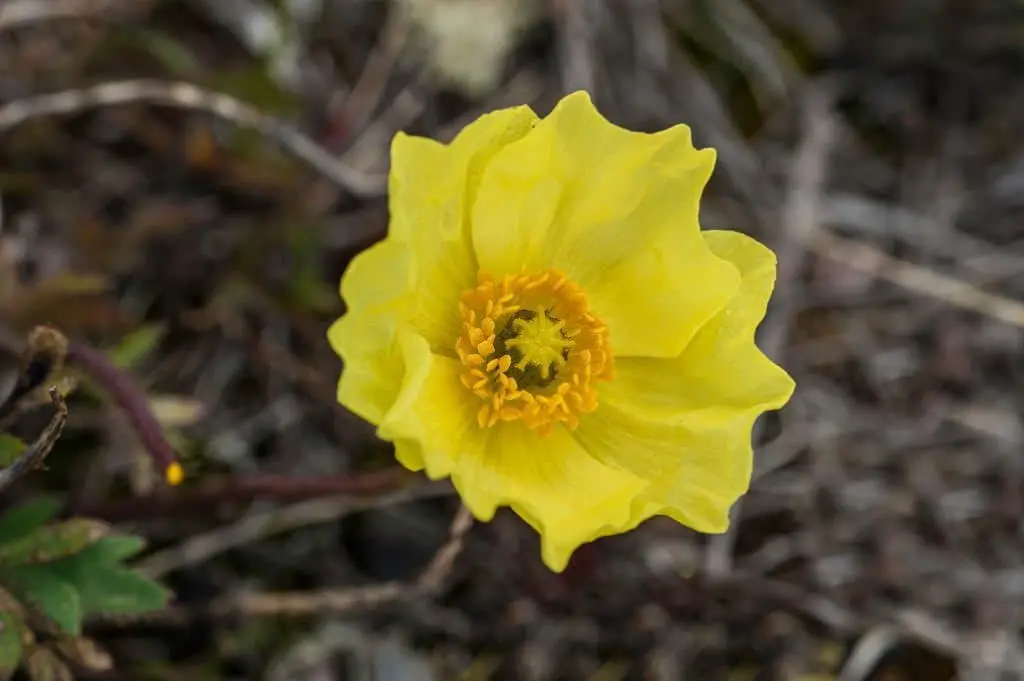
Perched at the top of the poppy family hierarchy, the Arctic poppy boasts a unique profile. Its rosette-shaped growth habit reaches approximately 20 cm tall, with leaves stretching up to 15 cm long and 12 cm across. The plant’s distinguishing feature is its vibrant yellow flower, adorned with four petals that can grow up to three cm in length. A striking orange-red blotch sits at the base of each petal, while the stamens remain relatively short.
The fruit capsule contains numerous seeds, serving as a testament to the plant’s reproductive prowess.
This hardy perennial is native to the Arctic tundra regions of North America, Europe, and Asia. While Alaska claims the highest concentration, it can also be found in northern Canada, Greenland, Iceland, Scandinavia, and Russia. The Arctic poppy thrives in dry environments with limited vegetation, such as rocky slopes and mountain meadows.
However, it’s not averse to wetter habitats, like marshes and bogs, where it coexists with other resilient flora.
Armenian poppy (Papaver armeniacum).
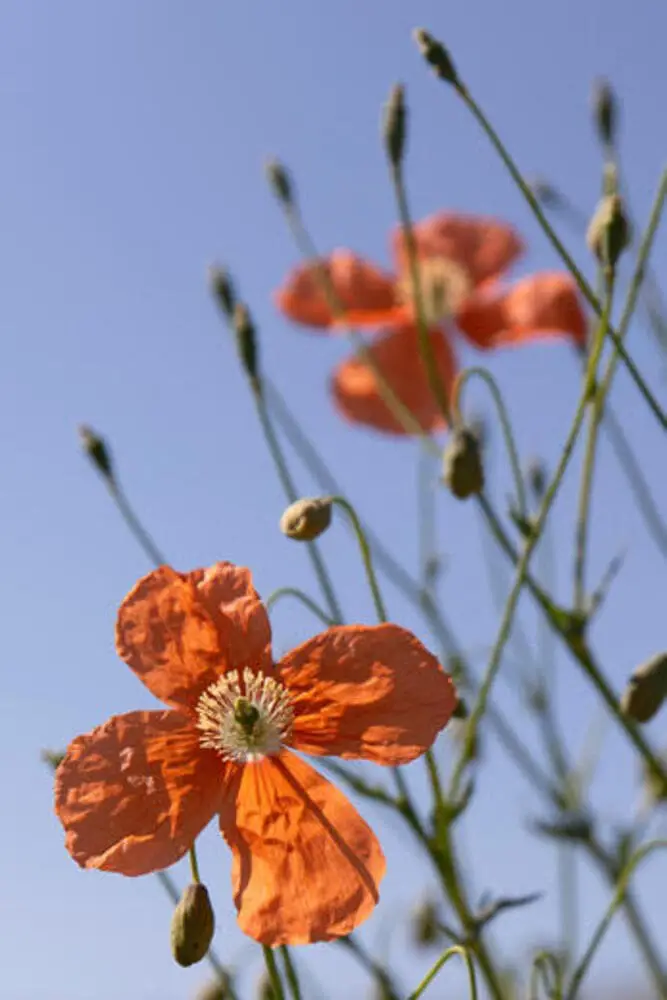
The Armenian poppy is a striking species of poppy that originates from the Caucasus region and surrounding areas. As a member of the Papaveraceae family, this flower thrives in early spring, boasting large, cup-shaped blooms with vibrant orange or red petals.
Standing approximately two feet tall, the plant features dark green leaves with deep lobes. Its hardiness makes it relatively simple to cultivate, and it flourishes in full sunlight, preferring well-drained soil.
As a popular choice for garden enthusiasts, the Armenian poppy is an excellent addition to any floral arrangement, and its blooms can also be used as cut flowers.
Bloodroot (Sanguinaria canadensis).
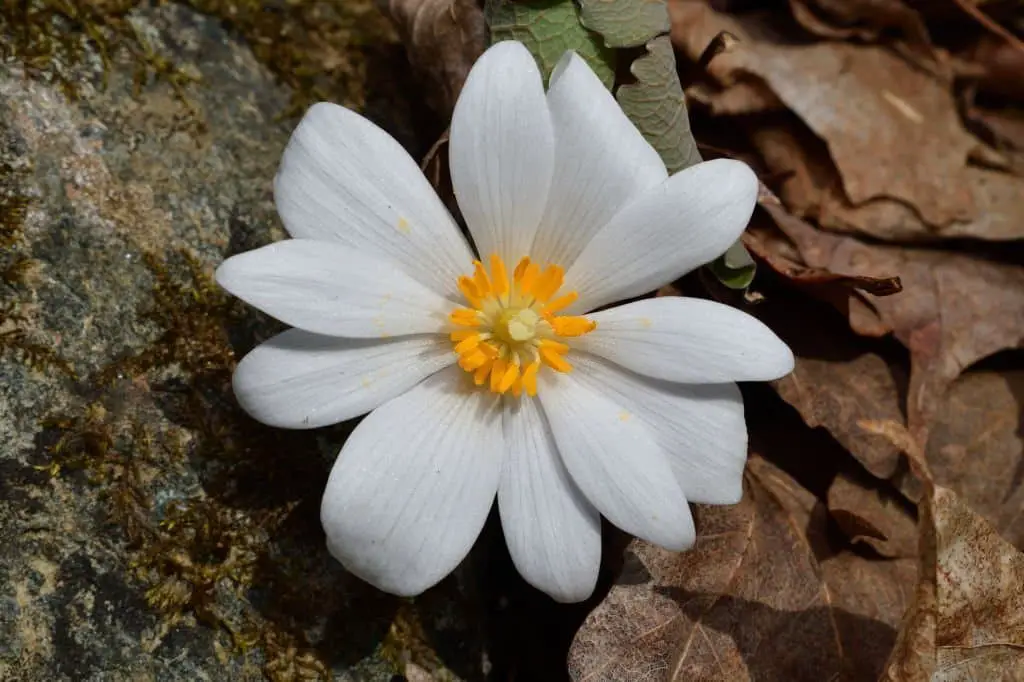
In the eastern United States and Canada, bloodroot thrives in woodland environments. The plant’s name originates from the reddish sap that flows from cuts made to its root. This ancient remedy has been employed by many Native American tribes for centuries. Its rich, moist habitat and preference for partial to full shade make it a staple of shaded woods. In early spring, bloodroot bursts forth with white blooms, often preceding leaf growth.
This perennial can be multiplied through seed or division. Seeds should be sown promptly after ripening in a cold frame or under a shaded canopy. Division can be performed in the spring or fall, allowing for flexibility and adaptability to different growing conditions.
Bloodroot is perhaps most renowned for its traditional use as an herbal medicine. It has been employed to treat a range of ailments, including respiratory infections, skin problems, and digestive issues.
In some cases, it has even been used to combat cancer.
California Poppy (Eschscholzia californica).
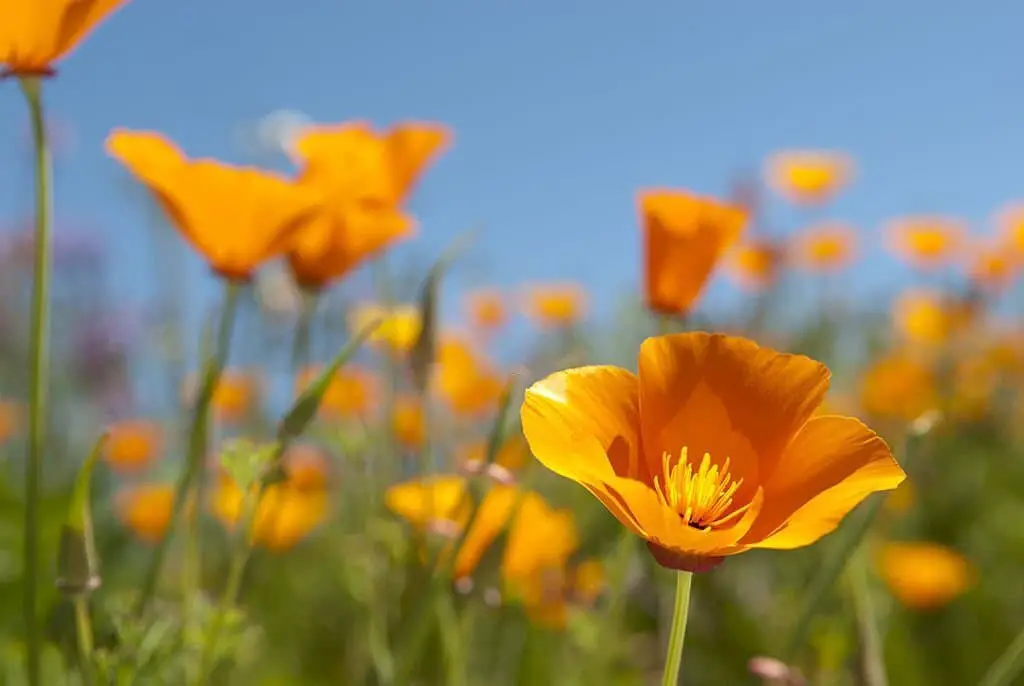
The California poppy, scientifically known as Eschscholzia californica, is a remarkable flowering plant native to the western United States and Mexico. As a member of the Papaveraceae family, it thrives in its natural habitat with an annual growth pattern, although under favorable conditions, it can live for multiple years.
This iconic plant has earned several nicknames, including golden poppy, la amapola, and copa de oro, but its most esteemed title is as the official state flower of California.
The California poppy’s physical characteristics are equally impressive. Its slender stem reaches a height of 20-60 cm (0.79-23.62 in), supporting leaves that alternate in arrangement, with hues ranging from blue-green to olive-green and often exhibiting a soft hairy texture.
The leaf margins are smooth and entire, lacking any serrations or teeth.
The true pièce de résistance, however, is the poppy’s showy blooms. These can appear singly or in clusters of two or three, boasting four erect to spreading petals that display an array of colors including orange, yellow, white, pink, and red. The fruit that follows this floral display is a capsule containing numerous small seeds.
Celandine Poppy (Stylophorum diphyllum).
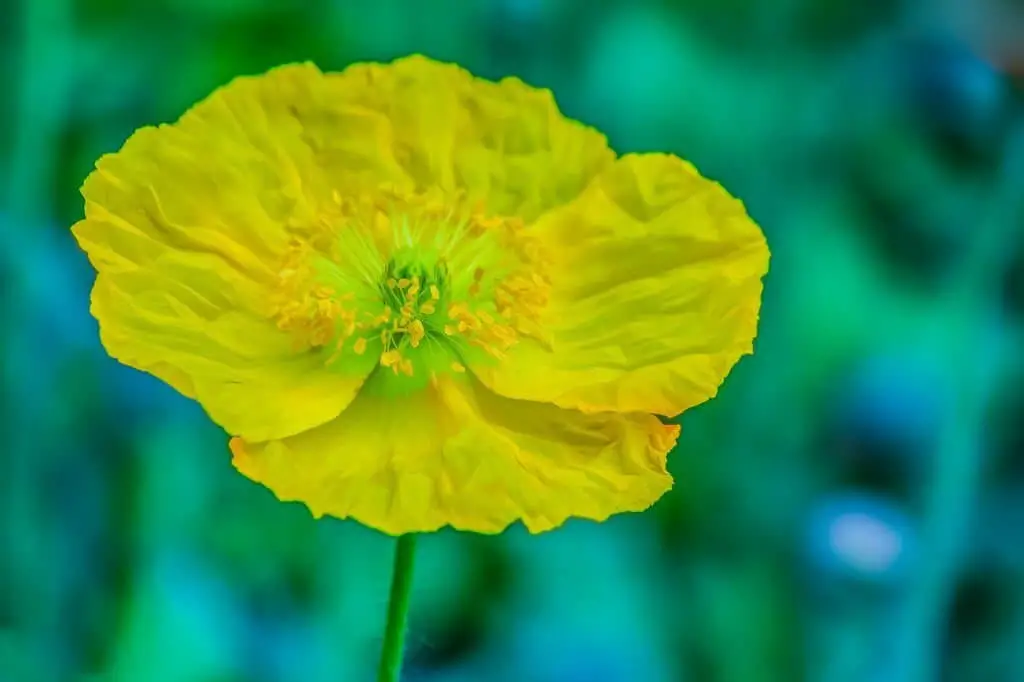
The celandine poppy, a vibrant yellow bloom, heralds the arrival of spring in eastern North America’s woods and meadows. Native to this region, the flower boasts two prominent petals and four smaller ones, surrounded by a bright yellow cup-shaped center. Measuring around two inches in diameter, these blossoms are a stunning sight. The plant itself grows to an average height of approximately two feet.
As a member of the poppy family, Styphorum diphyllum is a unique species with several common names, including wood poppy, yellowwood poppy, and American celandine. Its striking appearance and modest size make it a charming addition to any natural setting.
Corn Poppy (Papaver rhoeas).
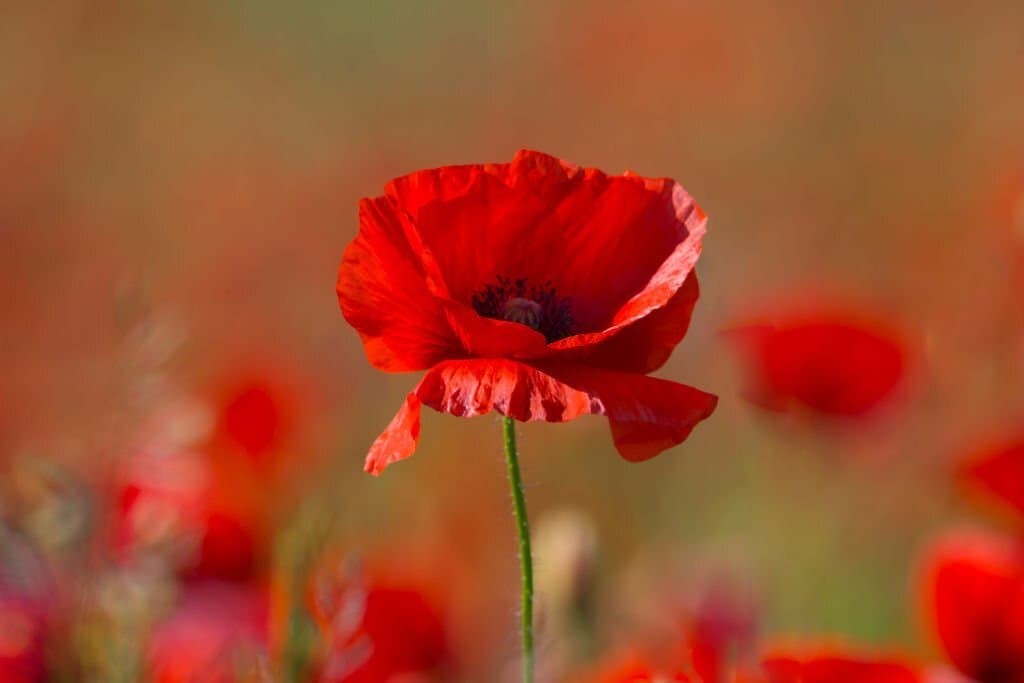
The corn poppy, scientifically known as Papaver rhoeas, is a striking annual flowering plant that belongs to the poppy family. This family includes a range of notable species such as breadseed and opium poppies. Native to Europe and Asia, the corn poppy has been naturalized in North America and other regions around the world.
Standing tall at 30-100 cm (12-39 in) in height, this plant boasts alternate, simple, and lobed leaves.
Its solitary or clustered flowers feature four vibrant red petals. The fruit of the corn poppy is a capsule that encases numerous small seeds.
While often viewed as a weed, the corn poppy also enjoys popularity as an ornamental plant. Interestingly, it holds a special status in California, serving as the state flower, and in Canada, where it has been designated as the official flower of Remembrance Day.
Desert Bearpaw Poppy.
The desert bearpaw poppy’s striking appearance belies its resilience in the harsh desert landscape. Its vibrant yellow center is surrounded by delicate orange petals, making it a breathtaking sight. Beyond its aesthetic appeal, this flower holds significant symbolic value – it represents hope and determination for many individuals. Gazing upon its beauty serves as a poignant reminder to persevere in the face of adversity, never losing sight of our aspirations.
Dwarf poppy or Alpine poppy (Papaver alpinum).
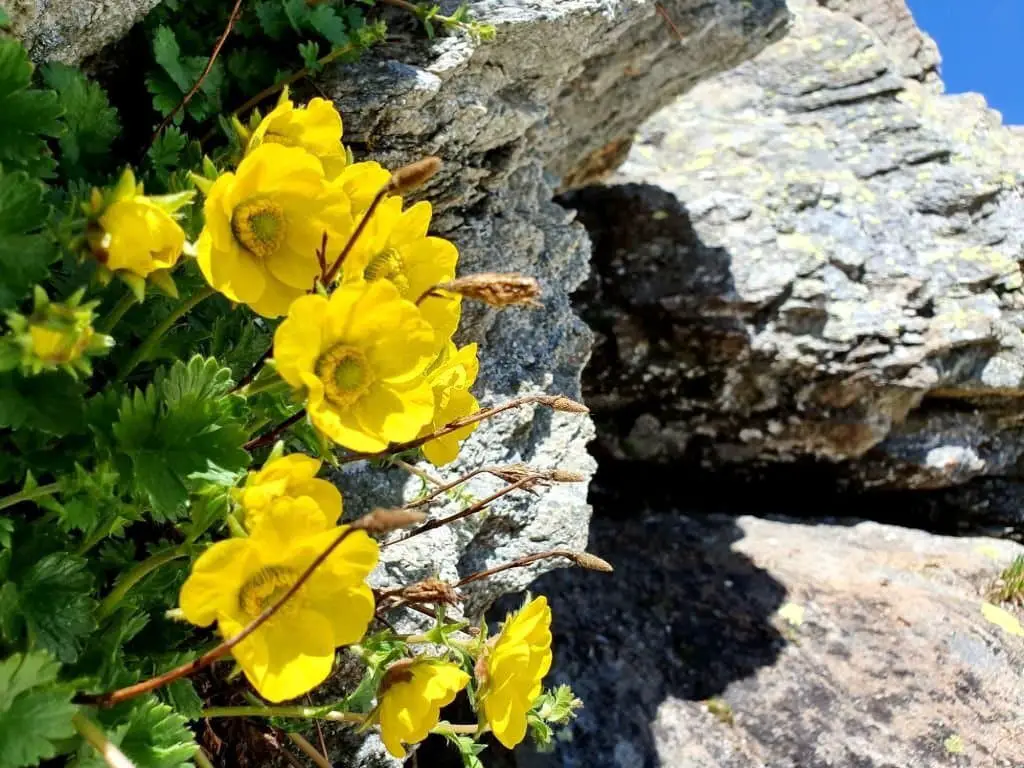
A diminutive yet charming member of the poppy family, the dwarf poppy (its exact scientific classification remains unclear) thrives in the rugged terrain of Europe’s mountain ranges. Specifically, it can be found in the Alps, Pyrenees, Carpathians, and other similar regions, as well as the Caucasus and parts of Asia. This perennial plant is distinguished by its solitary flower featuring four petals, which typically appear in shades of white or pink.
Reaching a modest height of 15 cm (six inches), the dwarf poppy is an unassuming yet endearing addition to any garden. The plant’s flowering period typically occurs in June and July, with individual blooms lasting around two to three weeks. As a result, it has gained popularity among gardening enthusiasts who prize its delicate beauty and low-maintenance requirements.
Preferring full sun, but capable of adapting to partial shade, the dwarf poppy demands well-drained soil and abhors wet conditions. Its drought-tolerant nature allows it to flourish in dry environments, making it an attractive choice for gardeners seeking a resilient yet visually appealing addition to their outdoor spaces.
Fire Poppy (Papaver californicum).
In the golden state of California, a tiny yet striking beauty can be found – the fire poppy. A member of the Papaveraceae family, this charming perennial is closely related to the opium poppy and shares its striking orange-red hue. Reaching heights of 12-18 inches, the plant’s short-lived blooms are characterized by crinkled petals with a ruffled appearance, measuring two to three inches across.
At the center of each flower lies a cluster of black seeds, adding an air of mystery to this already captivating bloom. The fire poppy thrives in dry, open habitats such as grasslands, chaparral, and woodlands, making it a common sight in California’s Sierra Nevada foothills, San Francisco Bay Area, and Santa Monica Mountains. If you’re eager to catch a glimpse of these vibrant flowers, springtime is the perfect time – March to May are the ideal months to witness the fire poppy in all its glory.
However, don’t expect them to remain in bloom for long; after just a few weeks, they’ll scatter their seeds and go dormant, only to regrow anew.
Greater Celandine (Chelidonium majus).
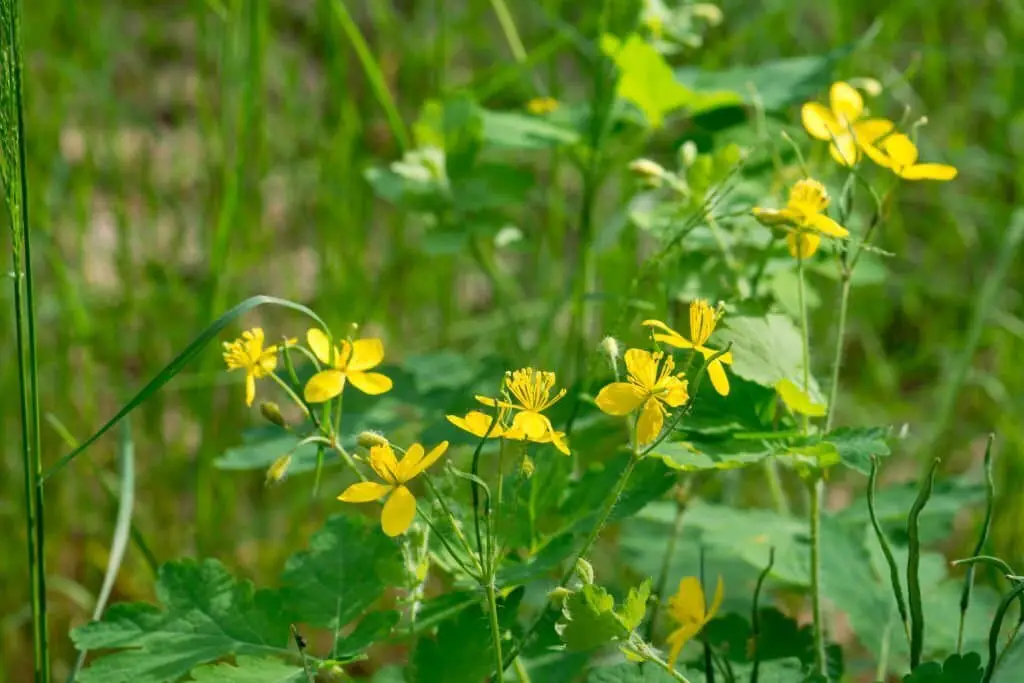
Hailing from Europe, North Africa, and western Asia, this plant is a member of the poppy family. Its introduced presence in North America has led to its naturalization in certain parts of the United States. As a perennial herb, it can grow up to two or three feet tall, boasting large leaves with deeply lobed, dark green surfaces that glisten with a subtle shine. The flowers are a vibrant yellow and emerge in clusters on stems sprouting from the leaf axils.
The fruits take the form of small, round black seeds enclosed in delicate, papery capsules.
Himalayan Poppy (Meconopsis grandis).

In the Himalayan mountains, a stunning perennial poppy thrives from late spring to early summer. Reaching 30-60 cm (12-24 inches) in height, this majestic plant boasts cup-shaped blooms that typically burst forth in shades of blue and purple. While they can be challenging to cultivate outside their natural habitat, Himalayan poppies make exquisite and enduring cut flowers.
Hungarian Breadseed Poppy.
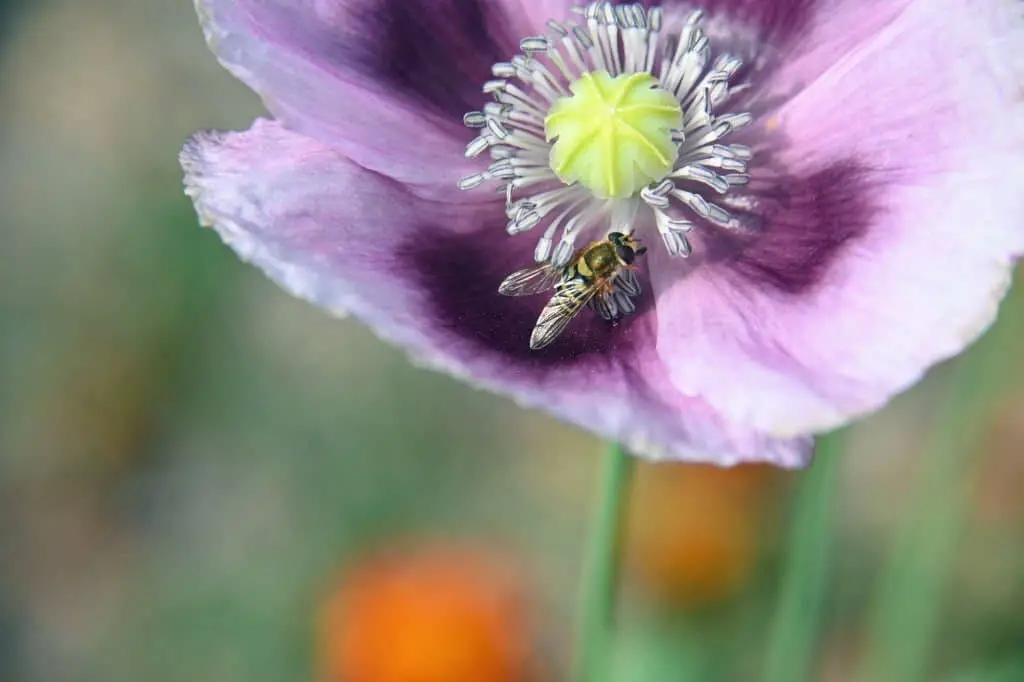
Papaver somniferum, the botanical name for the Hungarian Breadseed poppy, is an annual plant that grows to heights between 30-60 centimeters. Its bluish-green leaves and white, pink, or red flowers with four petals and a diameter of approximately four centimeters are notable characteristics. The plant’s blooming period typically occurs during June and July, with the summer months serving as its prime time for flowering.
Native to Europe and Asia, the Hungarian Breadseed poppy has been cultivated across many regions for its edible seeds, which find applications in baking and cooking. Furthermore, these seeds serve as a vital food source for various bird and animal species. Interestingly, the plant’s flowers can also be utilized to create a soothing tea.
Ice poppy (Papaver croceum).
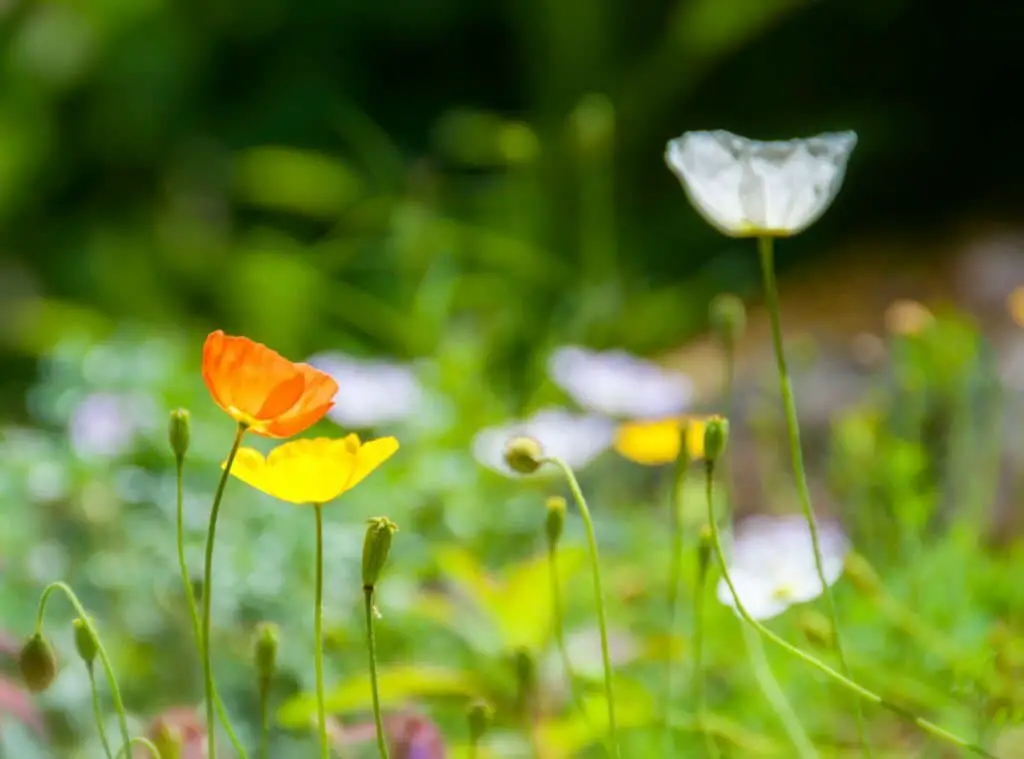
Add the stunning annual poppy to your garden collection! Its dainty blooms will instantly elevate any outdoor space, bringing a touch of elegance and charm. What’s more, this variety is surprisingly low-maintenance, making it an ideal choice for novice gardeners. As an added bonus, ice poppy is remarkably resilient when it comes to drought conditions, allowing you to enjoy its beauty even on the hottest summer days.
Iceland Poppy (Papaver nudicaule).
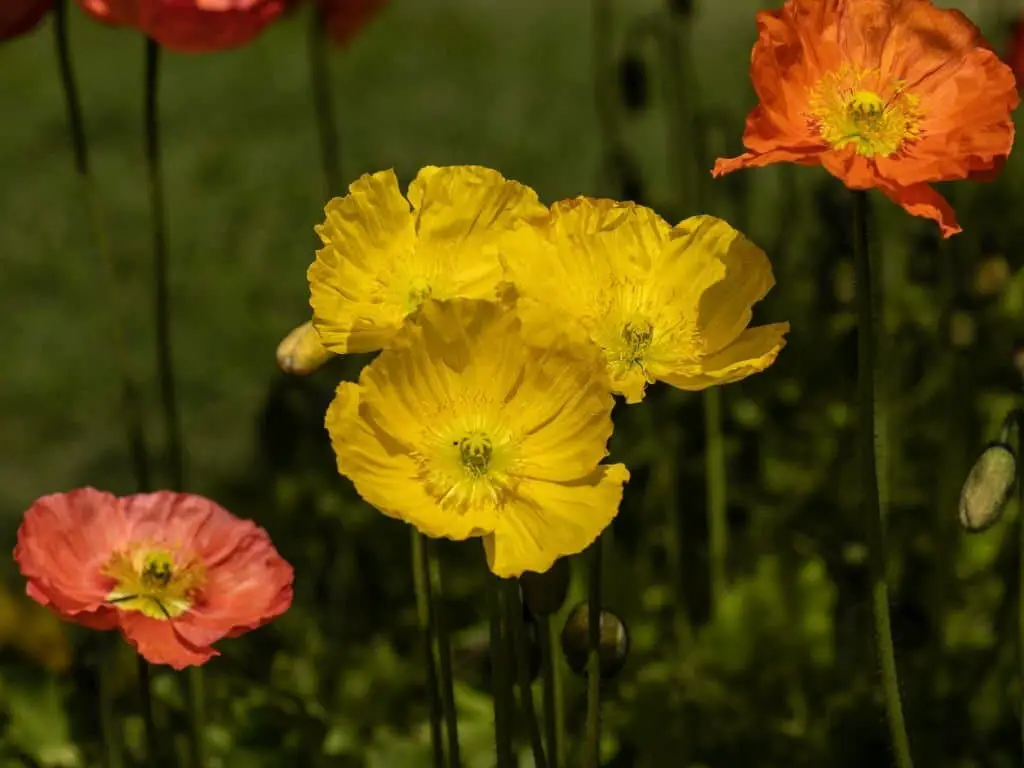
Icelandic charm unfolds as early summer arrives with the blooming of a stunning little flower, a member of the poppy family that hails from its namesake country. This delicate beauty reaches heights of around 12 inches (30 cm), showcasing papery blooms in an array of colors including white, yellow, pink, orange, and red. The single petal’s curled edges lend a ruffled appearance, making it a sought-after addition to bouquets and floral arrangements.
Iceland poppies are relatively low-maintenance and thrive in full sun or partial shade, with a preference for well-drained soil that can tolerate some drought once established. While they have the tendency to self-seed and potentially become invasive if not controlled, their short-lived perennial nature means replanting may be necessary every few years.
Iranian poppy or Persian poppy (Papaver bracteatum).
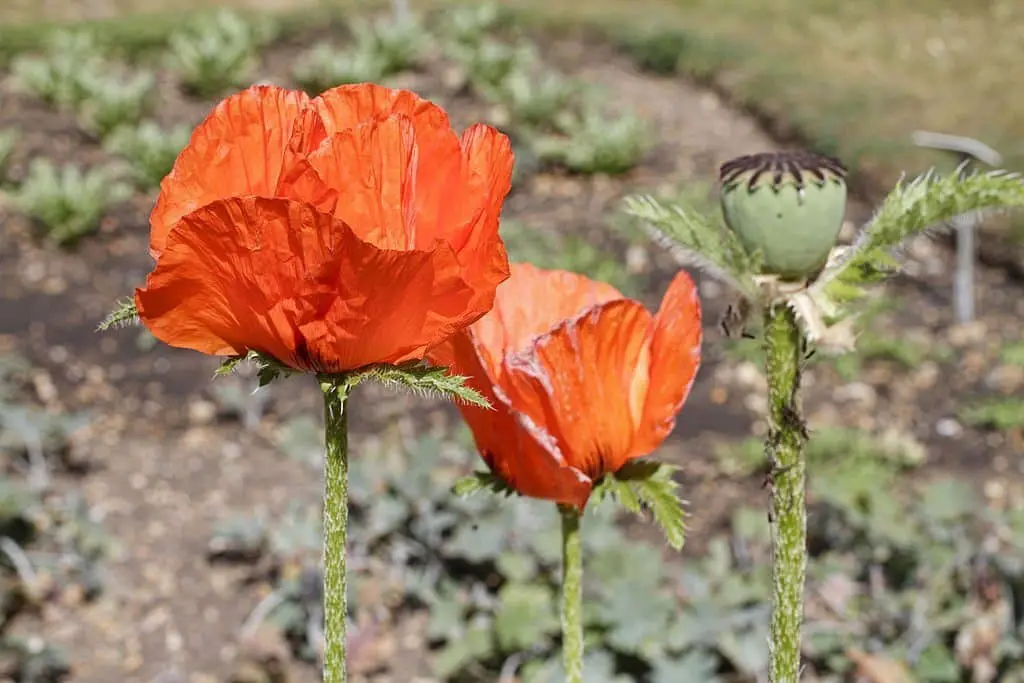
The Iranian poppy boasts an impressive display of flowers, characterized by four broad and deeply notched petals. While the most common hue is a vibrant red, white, pink, and purple varieties also thrive. To flourish, this species requires full sun and well-drained soil. Its showy blooms and low maintenance make it a sought-after choice for gardens and parks.
As a member of the Papaveraceae family, the Iranian poppy is native to Iran, Afghanistan, and Turkey.
The plant reaches a height of 30-60 cm (12-24 in), with lobed leaves that are green on top and feature a silvery sheen underneath.
Long-headed poppy (Papaver dubium).

The long-headed poppy, a charming member of the poppy family, boasts delicate petals and a slender stem. Its affinity for woodland settings and hedgerows is undeniable, thriving in damp, shaded environments that provide it with the perfect conditions to flourish. This lovely bloom typically emerges from May to June, bringing a touch of elegance to any garden or outdoor space.
Matilija Poppy (Romneya coulteri).
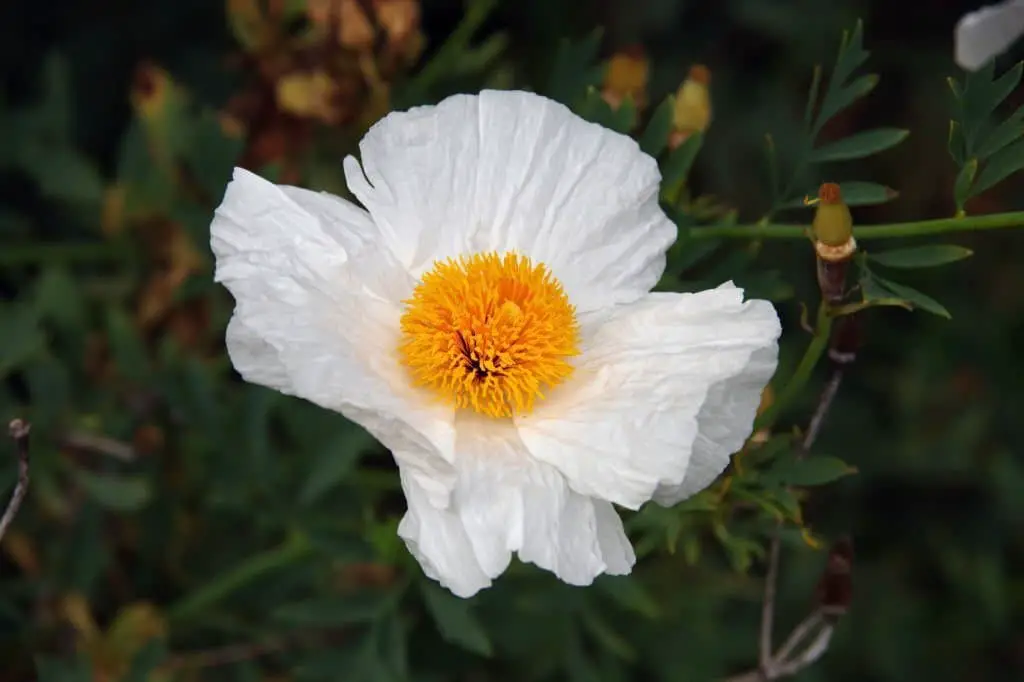
The Matilija Poppy, also known as the bush poppy, tree poppy, or bigbud poppy, is a striking member of the Papaveraceae family. Its showy flowers emerge in early summer, boasting large white petals and bright yellow stamens. The plant’s foliage is equally impressive, featuring leaves divided into 11-19 lobes that are covered in silvery-grey hairs.
Reaching heights of up to three meters, the Matilija Poppy is a commanding presence in its native habitats of Southern California and northern Baja California. It thrives in chaparral and coastal sage scrub environments, where it’s been named after Spanish botanist Mariano Matilija (1724-1787) in his honor.
Opium Poppy (Papaver somniferum).
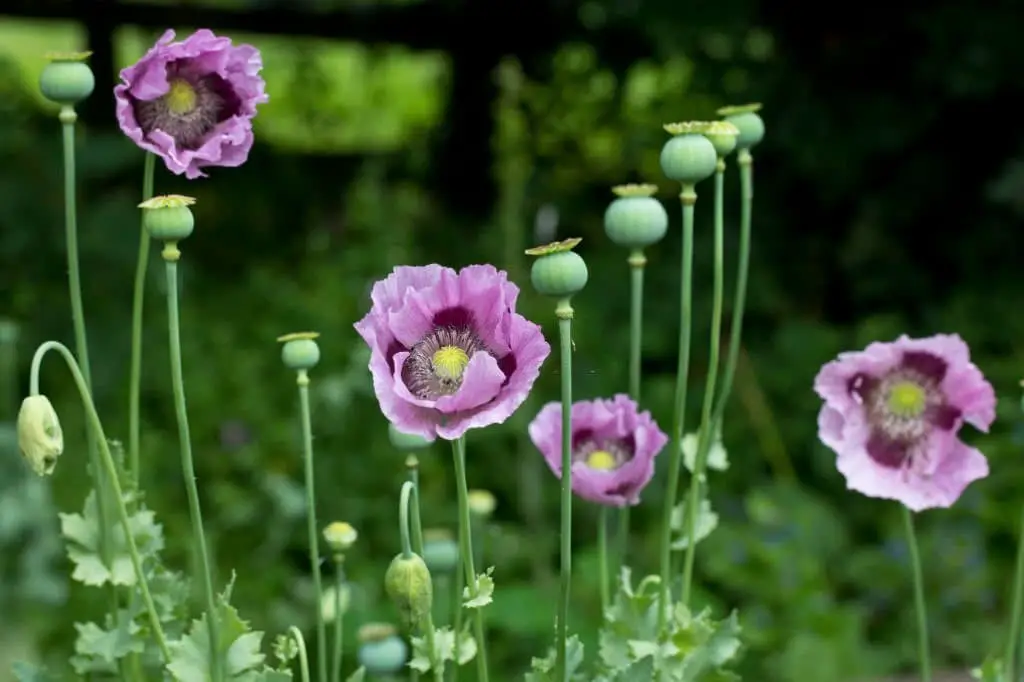
While many may perceive it as a delicate flower, the opium poppy has a rich historical background. Its medicinal properties have been utilized for centuries, with one of its most notable byproducts being opium – a substance notorious for its addictive nature. Native to Asia, the opium poppy was first cultivated in ancient China around 3400 BC, subsequently spreading to India, the Middle East, and eventually Europe. Throughout history, opium has been employed to alleviate pain and induce sleep.
Its usage dates back to the ancient Greeks and Romans, who relied on it as a treatment for various ailments. In the 18th century, European medical practitioners also adopted opium as a remedy for conditions such as diarrhea, toothache, and childbirth-related discomfort.
Oriental Poppy (Papaver orientale).
The Oriental poppy is a stunning harbinger of spring, its vibrant blooms a joyous respite from the cold winter months. Native to Asia, this annual flower has been cherished in European gardens for centuries, where it’s part of the diverse Papaveraceae family, which comprises both short-lived and long-lasting species. As an annual plant, once the Oriental poppy has bloomed, its life cycle comes to a close.
While red is the most iconic hue, these flowers can also be found in radiant white, soft pink, or regal purple shades. Characterized by their large, cup-shaped blooms with four petals, they rise up on sturdy stems before making way for the next season’s growth. With a relatively short blooming period of just two to three weeks, it’s essential to appreciate these poppy gems while you can.
Plume Poppy (Macleaya cordata).
Plume Poppy (Macleaya cordata) is a stunning perennial herb belonging to the poppy family, Papaveraceae. Native to East Asia, specifically China and Korea, it has gained popularity as an ornamental plant in temperate regions for its impressive leaves and vibrant flowers.
The genus name Macleaya honors Scottish botanist Mungo Park (1771-1806), who first discovered the plant during his expeditions in China. The specific epithet cordata refers to the heart-shaped shape of the leaves.
Characterized by its large, deeply lobed or pinnate leaves that can grow up to 80 cm long and 50 cm wide, Plume Poppy is a striking addition to any garden or park. Its showy flowers are white or pink, measuring up to 15 cm across with four petals. The fruit of the plant is a capsule containing numerous black seeds.
Beyond its ornamental appeal, Plume Poppy has also been used in traditional Chinese medicine.
The leaves and roots are used to brew a tea that is said to possess medicinal properties. This tea is often consumed to alleviate symptoms of colds, flu, and other respiratory infections. It may also be used as a diuretic or to treat stomach issues such as indigestion and diarrhea.
However, it’s essential to note that the plant contains alkaloids that can be toxic in large doses.
As a result, Plume Poppy tea is not recommended for pregnant women, young children, individuals with liver or kidney disease, or anyone who may experience adverse effects.
Prickly Poppy (Papaver argemone).
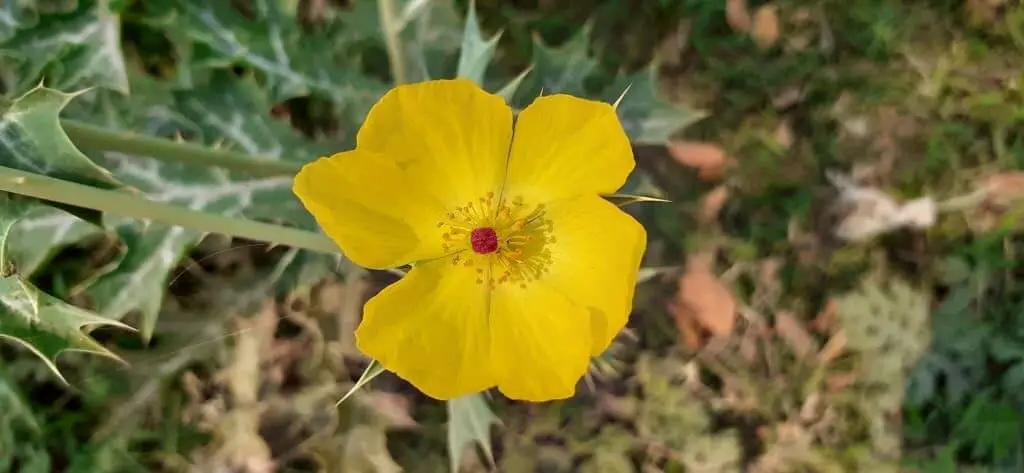
Across the western United States, a familiar sight can be found in neglected areas, alongside highways, and in other regions where human activity has left its mark – the bright yellow or white blooms of this wildflower species. Reaching heights of up to two feet, the plant’s vibrant flowers feature four delicate petals and an abundance of stamens, drawing attention to their beauty.
Once the flower has reached maturity, it produces a capsule that bursts open, releasing a multitude of tiny seeds for propagation.
Pygmy Poppy (Eschscholzia minutiflora).

The Pygmy Poppy, a small annual herb, is native to California and can be found in the southern Sierra Nevada, southern Coast Ranges, and Transverse Ranges. Characterized by its bright yellow flowers, the plant reaches approximately 20 cm in height. The blooms consist of four petals, arranged in a cup-shaped involucre, while the fruit takes the form of small, spherical capsules. This understated yet charming species thrives in open, disturbed habitats such as roadsides and fields.
Its brief blooming period occurs from March to May. Despite being easily overlooked, the Pygmy Poppy is a delightful little flower that can be spotted on a hike with a keen eye.
Semitic poppy (Papaver umbonatum).
The Semitic poppy (Papaver umbonatum), a native Levant species, boasts an annual habit with hairy stem and leaves. Its white or pink flowers feature four petals, while the fruit takes the form of a capsule containing black seeds. This versatile plant has been utilized as a food source and for medicinal purposes since ancient times, offering a rich supply of protein, vitamins, and minerals. The seeds can be processed into a nutritious flour, making it a valuable resource.
Additionally, the Semitic poppy is known for its narcotic properties, sharing a close genetic relationship with the opium poppy (Papaver somniferum), from which opium is derived. Furthermore, this plant has been used to produce recreational drugs like hashish and marijuana.
Spanish Poppy (Papaver rupifragum).

The Spanish Poppy, an annual native to the Iberian Peninsula, has become naturalized in much of Europe and North America. This striking plant reaches heights of 30-60 cm (12-24 in) with deeply lobed, hairy leaves that can extend up to 20 cm (12 in) in length. Its unique flowers are borne singly on upright stems, showcasing vibrant orange-red petals with a black center, each bearing a crumpled texture that gives the appearance of ruffles.
Tulip Poppy (Papaver glaucum).
The tulip poppy, a member of the poppy family, stands out for its annual growth habit, reaching heights between 30 and 60 centimeters (12 to 24 inches). Its leaves, exhibiting a unique blue-green hue, form a distinctive basal rosette. A notable feature of this plant is the striking white flowers with blue streaks, which have a diameter of approximately five centimeters (two inches). The tulip poppy’s flowering period spans from May to August, providing a visual treat during these months.
Interestingly, its natural habitat can be found in the Mediterranean region.
Wind Poppy (Papaver heterophyllum).
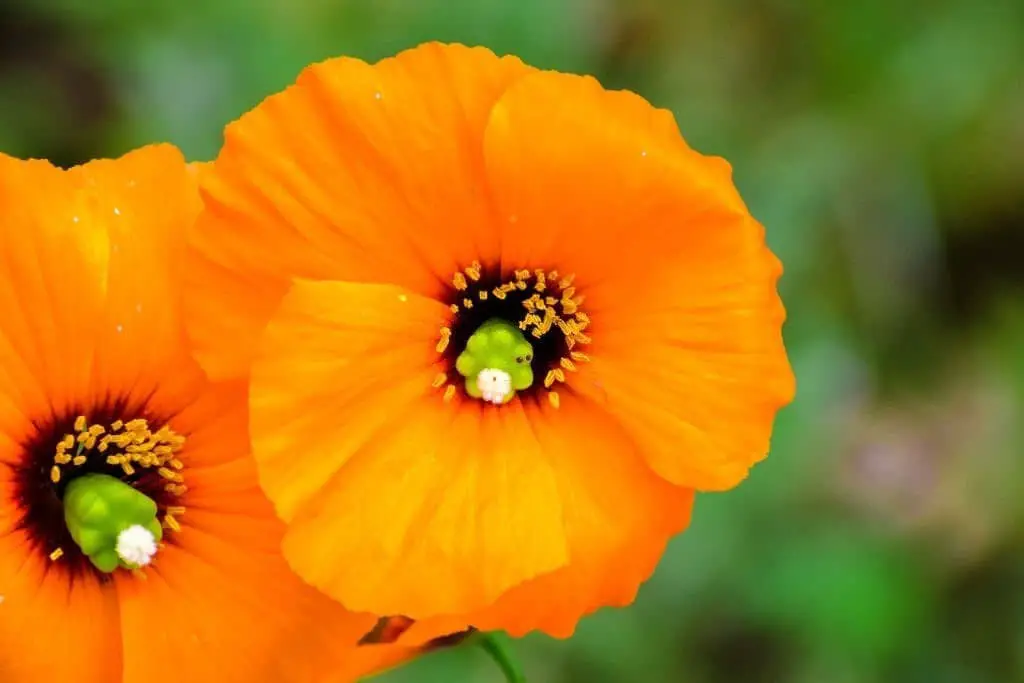
Wind poppy, a native California species, stands between 30-60 cm (12-24 inches) tall. Its leaves display a unique blue-green hue with deep lobes. The white flowers, featuring yellow centers, bloom in clusters. Fruiting capsules contain numerous small seeds. This drought-tolerant plant thrives in full sun and is commonly found in dry, open habitats like grasslands and chaparral. It’s often spotted in disturbed areas such as roadsides and vacant lots, where it can grow without issue.
In terms of similar flora, check out the 24+ Different Types of Windflowers to Admire This Spring for more spring-inspired beauty.
How to plant poppies
To bring a splash of color and vibrancy to your garden, poppies are an excellent choice. Not only do they thrive in full sun, but they can also be planted in fall, blooming beautifully come spring. To get started, identify a spot that receives at least six hours of direct sunlight daily. This will provide the ideal conditions for your poppy plants to flourish. Before planting, prepare the soil by loosening it with a shovel and incorporating compost or manure.
This will ensure your poppies receive the necessary nutrients to grow strong and healthy. You can either sow the seeds directly in the ground or start them indoors and transplant later. If you’re planting directly, do so in early fall, burying the seeds about an inch deep and watering thoroughly. Once germinated, thin out the seedlings to about six inches apart, allowing each plant room to grow and thrive.
Poppies are relatively low maintenance, but they do require regular watering to develop a robust root system. Make sure to water deeply, as this will support healthy growth. Additionally, deadhead spent flowers to encourage your poppies to produce more blooms throughout the growing season.
What is the best month to plant poppies?
For a successful poppy planting experience, consider timing your efforts during the fall season. This allows the young plants to establish themselves before the harsh winter weather sets in, giving them a head start on growth. If you live in an area with milder winters, you can also plant in late winter or early spring. However, it’s crucial to provide ample water to newly planted poppies until they become established.
As they mature and grow well, these hardy flowers prove surprisingly resilient to drought conditions, reducing the need for frequent watering.
How to care for poppies
Sun and shade needs.
For optimal growth, poppies require a location with full sun to partial shading. Ideally, they thrive in areas receiving at least six hours of direct sunlight daily. However, if you reside in an area prone to scorching summers, consider providing your poppies with some afternoon respite from the intense heat.
This can be achieved by planting them beneath trees or shrubs that cast dappled shadows, or by growing them in pots that can be easily relocated into the shade during the hottest part of the day.
Watering needs.
For optimal growth, poppies require consistent moisture, particularly during their initial stages of development. A thorough soaking once a week is typically sufficient, but this frequency may need to be adjusted based on prevailing weather conditions. In hot climates, for instance, it’s not uncommon for poppies to require more frequent watering to compensate for the increased evaporation.
Before irrigating, always inspect the soil to ensure it has dried out slightly, as overwatering can lead to root rot and ultimately result in the demise of your plant.
Temperature needs.
To ensure optimal growth, poppies require cool temperatures. For a successful harvest, plant them in the fall and let them bloom the following spring. If you reside in an area with scorching summers, select a location that receives afternoon shade to protect your plants from intense heat. Conversely, if you live in a region with cold winters, choose a spot that basks in full sunlight throughout the day. To insulate your poppies from the harsh elements, mulch heavily around each plant.
Keep in mind that poppies are not frost-tolerant and will perish if temperatures drop below freezing. If you’re faced with brutal winters, consider growing your poppies in containers that can be easily moved indoors when the weather turns cold.
Soil Needs.
When it comes to growing poppies, the type of soil you use is crucial. Ideally, you’ll want a well-drained soil with a neutral to slightly alkaline pH. If your soil is too dense or prone to waterlogging, consider creating a raised bed to give your poppies the room they need to thrive. Alternatively, you can try amending your existing soil by adding organic matter to improve drainage and create a more hospitable environment for your flowers.
Fertilizing needs.
Poppies, being heavy feeders, necessitate regular fertilization during their blooming season. A water-soluble formula with a balanced ratio of 20-20-20 or 30-30-30 is ideal. To ensure optimal results, carefully follow the package instructions for application rates. It’s crucial to avoid over-fertilization, as this can cause root burn and harm your poppy plants.
Pruning poppies.
For optimal growth, prune poppy stems to approximately two inches above ground level during late winter or early spring. This technique stimulates new development and results in more robust plants with fuller blooms. Additionally, remove spent flowers throughout the growing season to prolong blooming. In regions experiencing harsh winters, safeguard your poppies from frost by draping them in straw or burlap.
For added protection, apply a layer of mulch comprised of straw or leaves in the fall, as this will help insulate the roots and prevent winter damage. By providing proper care, you can expect your poppy plants to continue blooming for several years.
Repotting poppies.
When your poppies have outgrown their containers, it’s time for a repot. This usually happens every one to two years, but don’t wait too long – rootbound plants can struggle and even suffocate if they’re not given more space. To check if your poppy needs a new home, gently remove the plant from its pot and inspect the roots. If you notice them circling around the outside of the root ball or growing tightly together, it’s time to upgrade.
To repot your poppy with care, start by selecting a container that’s only slightly larger than the root ball. Avoid using a pot that’s too big, as this can lead to waterlogged soil and root rot. Instead, fill a new pot with fresh, well-draining mix and carefully transfer the plant into its new digs. Make sure not to disturb the roots excessively, as this can cause more harm than good.
Once you’ve settled your poppy into its new home, give it a good soaking and place it in a sunny spot where it can thrive.
Pests and Diseases.
Poppies, with their delicate charm, may seem invulnerable to pests and diseases. However, they can be vulnerable to a range of issues that can impact their growth and appearance. Some of the most common challenges faced by poppy growers include aphids, spider mites, and fungal diseases.
Aphids, those tiny sap-sucking insects, can cause stunted growth, distorted leaves, and even transmit viruses from plant to plant.
Spider mites, with their stealthy nature, can be a major problem despite being difficult to spot. They drain the sap of plants, leading to yellowing leaves and potentially, plant death.
Fungal diseases, such as powdery mildew and botrytis, pose another significant threat to poppies. These diseases can cause leaves to wither and drop off, while also causing flowers to rot.
FAQs
How many types of poppies are there?
While there are over 100 distinct species of poppies, one of the most well-known is the opium poppy (Papaver somniferum). This species, along with others like the California poppy (Eschscholzia californica) and Oriental poppy (Papaver orientale), make up a significant portion of the many varieties that exist. Interestingly, poppies can be found in a range of colors, including vibrant reds, soft pinks, pure whites, and even oranges, offering a diverse palette for nature enthusiasts to appreciate.
When do poppies bloom?
Poppies typically burst into bloom in late spring or early summer, with the Northern Hemisphere enjoying this colorful display between May and June. In contrast, the Southern Hemisphere sees its poppy blooms unfold from November to January. The exact timing of flowering depends on the specific species of poppy and local climate conditions. Some varieties will even re-bloom if their stems are cut back after the initial blooming period, usually occurring in late summer or early fall.
To encourage a second round of blooms, it’s essential to deadhead your poppy plants regularly.
Conclusion
Poppies are a true marvel of nature, boasting an incredible range of uses and applications. With over 100 different species to explore, you’re bound to discover the perfect poppy to suit your specific needs and desires. Whether you’re looking for a statement piece in your garden or a unique addition to your floral arrangements, these stunning flowers are sure to captivate and delight.
Their versatility is matched only by their beauty, making them an excellent choice for anyone seeking to add a touch of elegance and sophistication to their outdoor spaces.
Related Posts
When it comes to flower delivery, understanding gratuities for your floral courier is crucial. Whether you’re sending bouquets as gifts or treating yourself, knowing what to tip and why can make all the difference. Meanwhile, if you’re struggling with weeds featuring yellow flowers in your garden, don’t worry – we’ve got identification and removal tips to help you tackle the task.
And for those looking to add some color to their partial shade gardens or containers, colorful perennials are just what you need. In other news, African violet enthusiasts can find helpful advice on how to grow and care for this stunning plant, while those with shady spots can brighten them up with astilbe, a flowering perennial that’s perfect for adding some cheer.
And finally, for our friends in cold climates, we’ve got the top ten shade perennials you need to know about – tips and tricks for growing a lush shade garden that will thrive even in harsh conditions.






